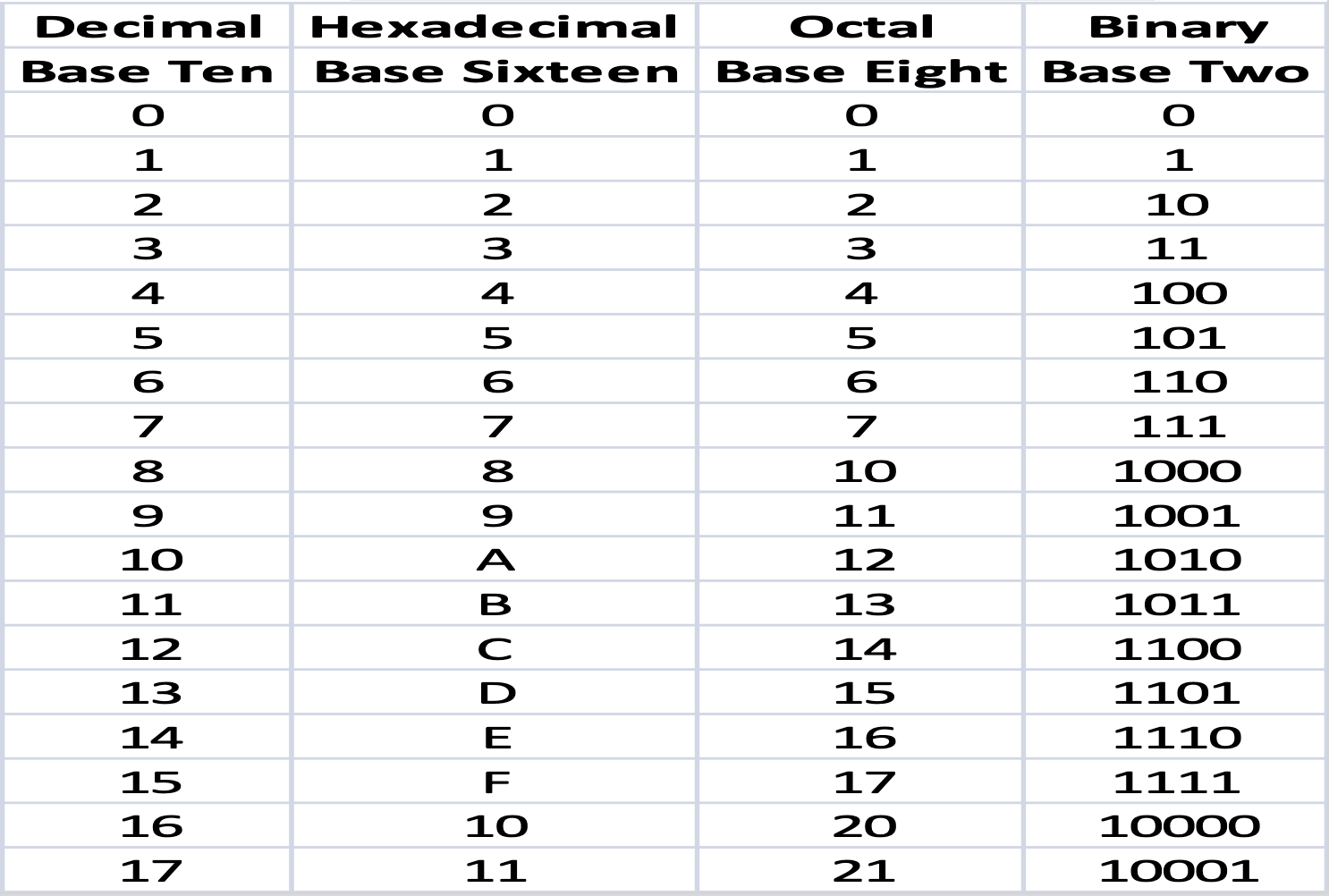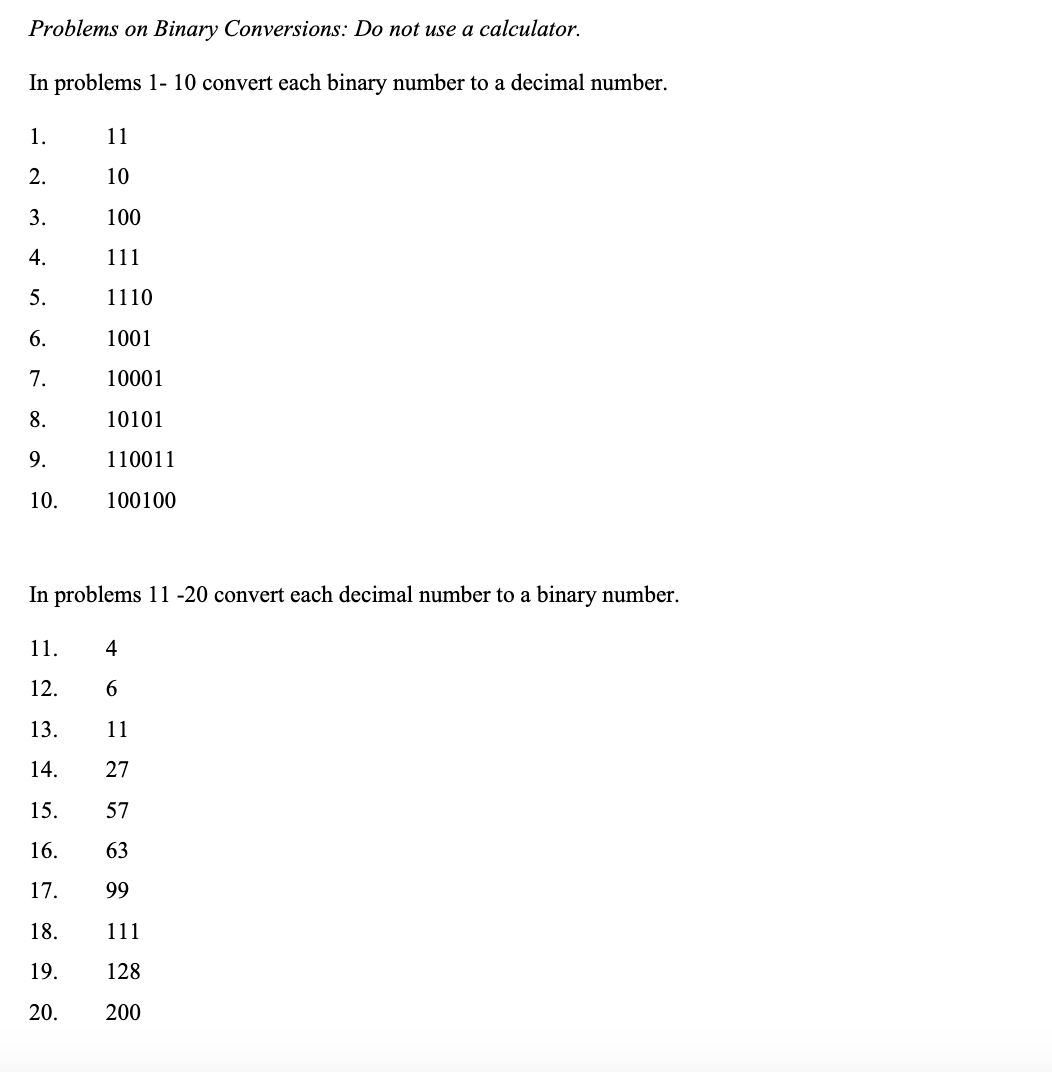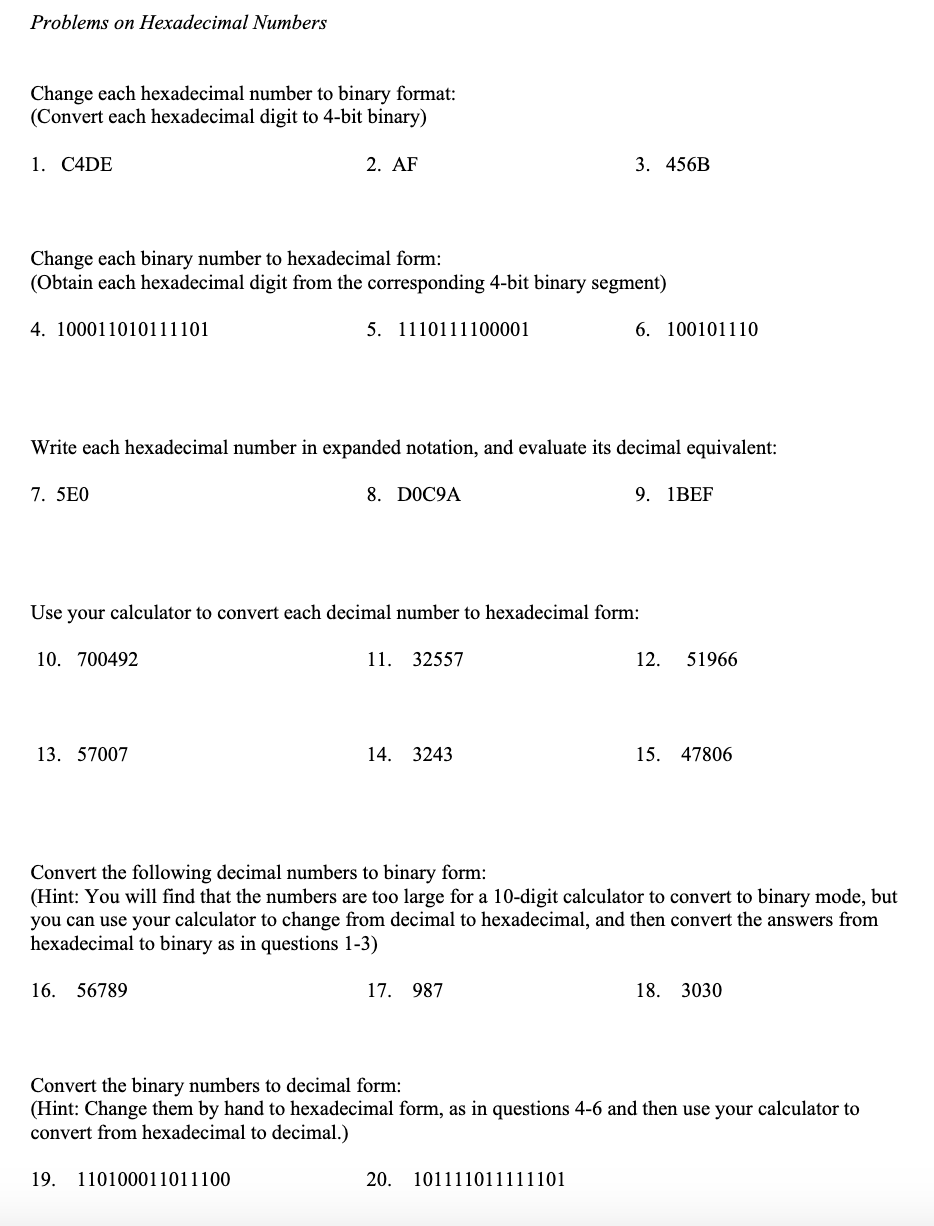[Func-Num] 4.4 The Common Computer-Oriented Base Conversions
Categories: Func-Num
Tags: Conversion Computer-Oriented
📋 This is my note-taking from what I learned in the class “Math175-002 Functions & Number Systems”
Base Converter Calculator
Some Decimal Equivalents in the Common Computer-Oriented Bases
(Use Table to Convert Between Hexadecimal/Binary/Octal)

Example 1: Converting from Octal to Binary
Convert 473eight to binary form. Each Octal digit is represented by 3 Binary digits
Solution
Octal 4 7 3 Binary 100 111 011 473eight = 100111011two
Exercise
Convert 514eight to binary form.
Solution
Octal 5 1 4 Binary 101 001 100 514eight = 101001100two
Example 2: Converting from Binary to Octal
Convert 10011110two to octal form
Solution
Binary (0)10 011 110 Octal 2 3 6 (0)10 011 110two = 236eight
Exercise
Convert 1101111two to Octal form.
Solution
Binary (00)1 101 111 Octal 1 5 7 (00)1 101 111two = 157eight
Example 3: Converting from Hexadecimal to Binary
Convert 8B4Fsixteen to binary form.
Solution
Each hexadecimal digit yields a 4-digit binary equivalent.
Hexadecimal 8 B 4 F Binary 1000 1011 0100 1111 8B4Fsixteen = 1000101101001111two
Exercise
Convert EBD9sixteen to binary form.
Solution
Hexadecimal E B D 9 Binary 1110 1011 1101 1001 EBD9sixteen = 1110 1011 1101 1001two
Example 4: Converting from Binary to Hexadecimal
Convert 10011110two to hexadecimal form.
Solution
Binary 1001 1110 Hexadecimal 9 E 1001 1110two = 9Esixteen
Exercise
Convert (0)1101111two to Hexadecimal form.
Solution
Binary (0)110 1111 Hexadecimal 6 F (0)1101111two = 6Fsixteen
Exercise
Section 4.4: 5 ~ 47 (odd)
List the first twenty counting numbers in each base.
- 5: seven (Only digits 0 through 6 are used in base seven.) → 0, 1, 2, 3, 4, 5, 6, 10, 11, 12, 13, 14, 15, 16, 20, 21, 22, 23, 24, 25
- 7: nine (Only digits 0 through 8 are used.) → 0, 1, 2, 3, 4, 5, 6, 7, 8, 10, 11, 12, 13, 14, 15, 16, 17, 18, 20, 21
Write (in the same base) the counting numbers just before and just after the given number. (Do not convert to base ten.)
- 9: 14five → 13, 20
- 11: B6Fsixteen → B6E, B70 → Solution link: List of Hexadecimal Numbers with base 16 subscripts
Determine, in each base, the least and greatest four-digit numbers and their decimal equivalents.
How to get the least and greatest numbers and decimal 1
How to get the least and greatest numbers and decimal 2
- 13: five → the least: 10005 → 12510, the greatest: 44445 → 62410
Convert each number to decimal form by expanding in powers and by using the calculator shortcut.
- 15: 3BCsixteen → 956
- 17: 2356seven → 874
- 19: 70266eight → 28854
- 21: 2023four → 139
- 23: 31544six → 4312
Convert each number from decimal form to the given base.
- 25: 147 to base sixteen → 9316
- 27: 36401 to base five → 21311015
- 29: 587 to base two → 10010010112
- 31: 9346 to base six → 1111346
- 33: 8407 to base three → 1021121013
Make each conversion as indicated.
- 35: 43five to base seven → 327
- 37: 6748nine to base four → 10313214
Convert each number from octal form to binary form.
- 39: 367eight → 111101112
Convert each number from binary form to octal form.
- 41: 100110111two → 4678
Make each conversion as indicated.
- 43: ACsixteen to binary → 101011002
- 45: 101101two to hexadecimal → 2D16
Identify the greatest number from each list.
- 47: 42seven, 37eight, 1Dsixteen → 37eight
e-Centennial Supplement pages 5 and 6 All. (Answers page: 13)

In problems 1~10, Convert each binary number to a decimal number
- 1: 11 → 3
- 2: 10 → 2
- 3: 100 → 4
- 4: 111 → 7
- 5: 1110 → 14
- 6: 1001 → 9
- 7: 10001 → 17
- 8: 10101 → 21
- 9: 110011 → 51
- 10: 100100 → 36
In problems 11~20, Convert each decimal number to a binary number
- 11: 4 → 100
- 12: 6 → 110
- 13: 11 → 1011
- 14: 27 → 11011
- 15: 57 → 111001
- 16: 63 → 111111
- 17: 99 → 1100011
- 18: 111 → 1101111
- 19: 128 → 10000000
- 20: 200 → 11001000

Change each hexadecimal number to binary format: (Convert each hexadecimal digit to 4-bit binary)
- 1: C4DE → 1100010011011110
- 2: AF → 10101111
- 3: 456B → 100010101101011
Change each binary number to hexadecimal format: (Obtain each hexadecimal digit from the corresponding 4-bit binary segment)
- 4: 100011010111101 → 46BD
- 5: 1110111100001 → 1DE1
- 6: 100101110 → 12E
Write each hexadecimal number in expanded notation, and evaluate its decimal equivalent:
- 7: 5E0 →
(5 * 162) + (14 * 161) + (0 * 160)
= 1280 + 224 + 0 = 1504
→ Decimal equivalent: 1504 - 8: D0C9A →
(13 * 164) + (0 * 163) + (12 * 162) + (9 * 161) + (10 * 160)
= 851968 + 3072 + 144 + 10 = 855194
→ Decimal equivalent: 855194 - 9: 1BEF →
(1 * 163) + (11 * 162) + (14 * 161) + (15 * 160)
= 4096 + 2816 + 224 + 15 = 7151
→ Decimal equivalent: 7151
Use your calculator to convert each decimal number to hexadecimal form:
- 10: 700492 → AB04C
- 11: 32557 → 7F2D
- 12: 51966 → CAFE
- 13: 57007 → DEAF
- 14: 3243 → CAB
- 15: 47806 → BABE
Convert the following decimal numbers to binary form: (Hint: You will find that the numbers are too large for a 10-digit calculator to convert to binary mode, but you can use your calculator to change from decimal to hexadecimal, and then convert the answers from hexadecimal to binary as in questions 1-3)
- 16: 56789 → 1101110111010101
- 17: 987 → 1111011011
- 18: 3030 → 101111010110
Convert the binary numbers to decimal form: (Hint: Change them by hand to hexadecimal from, as in questions 4-6 and then use your calculator to convert from hexadecimal to decimal)
- 19: 110100011011100 → 26844
- 20: 101111011111101 → 24317

Leave a comment